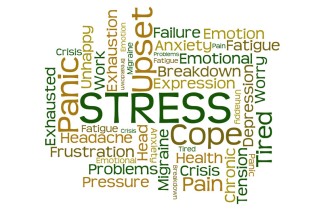What is Stress?
“Any intrinsic or extrinsic stimulus that evokes a biological response is known as stress” – Yaribeygi, H., Panahi, Y., Sahraei, H., Johnston, T. P., & Sahebkar, A. (2017) – so let’s be realistic, everyone has stress in their lives. However, if stress is having a negative impact on our behaviour or our wellbeing, we need to identify and reduce the triggers.
The Effects of Stress
Stress may induce both beneficial and harmful effects. Some stress is good for us as it helps us to respond t

o changes in life, preserving homeostasis of cells, leading to continued survival of the species. However, severe and prolonged stress causes harm to our mental and physical health and to our relationships.
It appears that bBeing exposed to stress can cause pathophysiologic changes in the brain, and these changes can be manifested as behavioral, cognitive, and mood disorder. (Li et al., 2008). Past studies demonstrated that high concentrations of stress hormones can cause declarative memory disorders and that stress also has negative effects on learning. (Yaribeygi et al., 2017)
Identify the Triggers
I highly recommend that we all try to identify the causes of stress in our lives and our pets’ lives so that we can begin to eliminate or reduce the stressors that may be adversely affecting our, or their, mental or physical wellbeing. Identifying the triggers – those stimuli such as a smells, sounds or sights that provoke feelings of fear, anxiety or stress – also means that we are better able to prevent trigger-stacking and thus avoid the very negative impact of cumulative stress on both our wellbeing and our behaviour.
Recommendations for Reducing Our Pets’ Stress
– If your pet demonstrates signs of fear, anxiety or stress, try to resolve the problem and make them more comfortable.
– Deliver tasty bite-sized pieces of food to help your pet create positive associations with situations, people or other animals.
– Work at a distance from the ‘stressor’/at a level where your pet feels comfortable.
– Avoid putting your pet in situations which you know cause a fearful response.
– Contact an accredited force-free trainer/behaviour consultant who can conduct a functional assessment and implement a behaviour change programme. A combination of management strategies and operant and respondent conditioning protocols, such as systematic desensitisation and counterconditioning, can be used to change the pet’s behaviour and emotional response to a stimulus.
– In some cases, medication may be advised – please consult your veterinarian.
Stress Reducing Tips for Both Humans and Canines
– Help reduce anxiety levels by incorporating more daily exercise – go for a walk or run; a hike in the woods; a stroll on the promenade…
– Spend time enjoying the company of friends and family.
– Fuel your body with a balanced diet.
– Use natural scents to promote calmness and relaxation (pet pheromone products come in various forms, including sprays, plug-in diffusers, wipes, and collars).
– Get enough rest. Crate training can be of particular benefit to a dog providing them with a cosy retreat. Your bedroom and your pet’s should be a safe haven.
Engage in Fun Activities
Do something fun every day. This could be anything from a game of ‘fetch’; a stroll around your favourite shop; a ride in the car; a walk on the beach; a get-together with friends; a puzzle game – a crossword or jigsaw for you and an interactive toy for your pet; listen to music – calming background noise like classical music can be soothing for both of you; read a book (while lovingly stroking your pet, of course). Anything you both enjoy!
Learn to Recognise Canine Signs of Stress
Here are a few telltale signs that a dog may be experiencing fear, anxiety or stress. Some may be ongoing, others will be specific to the stress-triggering event:
- abnormal/excessive urination or defecation
- destructive behaviour
- dilated pupils
- ears pinned back
- excessive barking/whining
- excessive grooming
- excessive panting
- excessive shedding
- freezing
- lip licking
- mounting
- moving away
- pacing
- paw raised
- skin and coat problems
- tail between legs
- tension in body and face
- trembling/shivering
- turning away
- yawning when not tired…
Avoid Trigger-Stacking.
 Is your dog stressed when you take him to the vet? Is you dog stressed when you clip his nails? Does your dog dislike wearing a muzzle? Is your dog stressed by the presence of children?
Is your dog stressed when you take him to the vet? Is you dog stressed when you clip his nails? Does your dog dislike wearing a muzzle? Is your dog stressed by the presence of children?
Work to resolve the problematic response associated with all of these fear or anxiety provoking triggers separately, and always avoid situations where trigger-stacking may take place – Your dog is muzzled for a visit to the veterinary office. On entering the clinic there is a a young child chasing around in the waiting room. After a lengthy wait you go into the vet’s office where your dog will be given a nail trim… One trigger on top of another and your petrified dog feels he has no option other than to growl, snap, bite…
Whenever Possible, Give the Pet a Choice
Allow the pet to have some control over the situation; foster collaborative care; use consent tests; give your pet a voice. “Understanding the many uses for and learning how to teach essential collaborative care behaviours will help pets happily cooperate in their own care. Collaborative care skills lead to a reduction in stress and anxiety for you, your clients and their pets. These important skills help everyone to remain calm in what could otherwise be fear-provoking situations” – DogNostics Career Center
A recent study published in the journal Scientific Reports, examining the factors which reduce the effects of stress, concluded that the ability to control the source of stress diminishes its effects and could reduce the risk of later developing mental disorders. (Universitat Autonoma de Barcelona, 2019). “Despite the fact that being exposed to situations of stress has short and long-term negative effects on behaviour and physiology, there are several factors which could mitigate its impact. We have observed that one of these factors is the possibility of having control over the source of stress,” affirmed Roser Nadal.
—
National Stress Awareness Week is run by the
International Stress Management Association (ISMA) with the aim of raising awareness, publicity and profile of stress and its impact; reducing the stigma often associated with stress, and promoting the importance of well-being and stress reduction for individuals and organisations.
Sources
Yaribeygi, H., Panahi, Y., Sahraei, H., Johnston, T. P., & Sahebkar, A. (2017).
The impact of stress on body function: A review.
EXCLI journal,
16, 1057–1072. doi:10.17179/excli2017-480
Li S, Wang C, Wang W, Dong H, Hou P, Tang Y. Chronic mild stress impairs cognition in mice: from brain homeostasis to behavior. Life Sci. 2008;82:934–942. [PubMed] [Google Scholar]
This blog was authored by L.A. Stapleton-Frappell and first published by DogNostics Career Center on 02 November, 2019 with the title: Stress Busting Tips for Humans and Pets!
 o changes in life, preserving homeostasis of cells, leading to continued survival of the species. However, severe and prolonged stress causes harm to our mental and physical health and to our relationships.
o changes in life, preserving homeostasis of cells, leading to continued survival of the species. However, severe and prolonged stress causes harm to our mental and physical health and to our relationships. Is your dog stressed when you take him to the vet? Is you dog stressed when you clip his nails? Does your dog dislike wearing a muzzle? Is your dog stressed by the presence of children?
Is your dog stressed when you take him to the vet? Is you dog stressed when you clip his nails? Does your dog dislike wearing a muzzle? Is your dog stressed by the presence of children?

